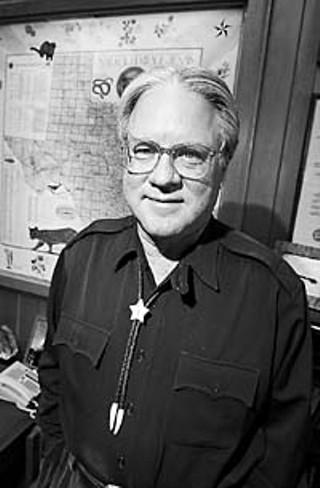A Shifting Landscape
Facing an Uncertain Future, Texas Parks & Wildlife Replaces a Visionary Leader
By Dan Oko, Fri., Feb. 8, 2002

At first glance, Andy Sansom doesn't necessarily strike one as the sort of "tough sumbitch" suited to laying down the literal law of the land in Texas, where an estimated 94% of all land is in private hands. Sansom's sandy hair, his gentle manner, and the reedy twang in his voice don't initially convey the air of authority one might expect from a fellow charged with convincing ranchers, cowboys, and hunters that -- concerning land development and a broad range of environmental concerns -- they need to respect the broad public interest in what goes on within their fence lines. But in his 11 years as executive director of Texas Parks and Wildlife, Sansom did just that: set forth programs designed to conserve habitat, protect and enhance recreational opportunities, and ensure wildlife resources for generations to come.
Sansom was hired by the state from the Nature Conservancy in 1987, during the tenure of Gov. William Clements -- when TPW was mired in a stench of scandal due to apparent conflicts of interest within the agency, carrying over from as far back as the Fifties. Sansom began his tenure overseeing land acquisition, and ascended to the directorship in 1990. For more than a decade, until January 1 of this year, he alternately cajoled and confronted powerful landowners who often view the Legislature as no more than a tool to protect their property rights, and the agency as an annoying obstruction in that process. Simultaneously, he worked to build alliances among cantankerous environmentalists, dedicated sportsmen and -women, and a burgeoning group of Texans more inclined to watch birds than shoot them. Sansom survived the governorships of both Ann Richards and George W. Bush, giving little indication of his future plans until last fall, when he announced his departure following the appointment by Gov. Rick Perry of a new set of TPW commissioners (see below).
Given his continued commitment to conservation -- the 56-year-old Sansom jokes that he'll probably be raising money for public land acquisitions on his deathbed -- Sansom's departure struck a blow to the Perry administration, widely viewed as having a blind spot for the environment. During his tenure, Sansom helped establish the Dallas-based Texas Parks and Wildlife Foundation, a nonprofit private corporation that to date has raised more than $30 million for state parks. In addition, he placed 12 million acres of private farm and ranch land into voluntary conservation agreements, and championed the creation of state-of-the-art fresh- and saltwater fish hatcheries that will also double as educational facilities.
On Monday, to the relief of many both within and outside the conservation community, TPW commissioners replaced Sansom with agency veteran Robert L. Cook. Yet for many who considered Sansom a shining green star, his resignation confirmed suspicions that Perry just doesn't care a lot about environmental issues. In addition, rumors that the two men had unfinished personal business gave the impression Perry may have forced Sansom out. Sansom denies that politics turned personal under Perry. Rather, he attributes his decision to leave TPW primarily to a desire for a change of scene, and secondarily to yet another arduous legislative session last year, a session that produced lackluster results with regard to funding and park infrastructure.
Since 2000, the TPW budget has been cut by more than $10 million -- from $256 million to just under $245 million -- forcing TPW to suspend hiring, delay vehicle purchases, and put off construction and maintenance work throughout the parks system. "There's never enough money for conservation," laments Sansom. "Texas Parks and Wildlife needs more money. All conversations start from there."
The Line of Succession
Almost universally lauded as a "visionary" director, Sansom nonetheless demurs at suggestions his legacy ought to be viewed as much more than a job well done. Although he touts the growth the agency has seen with regard to environmental protection, leading conservation efforts and cracking down on polluters and poachers, in recent conversations Sansom focused largely on his success in delegating responsibilities across the agency's extensive management echelon. Even on his way out the door, Sansom emphasizes the importance of balancing the weight of leadership with the need to supply constituents for the state's diminishing natural resources -- TPW employees included -- with a sense of ownership and vested interest in their preservation.

Given not only the geographic but the political landscape of Texas, Sansom could not have made the strides he did without trusted managers. The chronically under-funded TPW has nearly 3,000 employees and is made up of 10 management divisions, ranging from law enforcement and communications to coastal and inland fisheries departments. Says Joe Nick Patoski, a senior editor at Texas Monthly and one of the state's leading outdoors writers: "The balancing act he did between competing interests is nothing short of miraculous, especially given that Texas is a private-property state." It follows that when Sansom finally cleaned out his desk and left the agency last month, he left big shoes to fill.
Sansom trusts that Bob Cook will be the right choice for that job; in fact, on the eve of Cook's nomination, Sansom had already indicated it would be best if the TPW commission selected somebody from within the agency. "I am very pleased," Sansom says now. "Bob knows the department, he's a very ethical individual, and I'm sure he'll do a great job."
Others have thrown their weight behind Cook as well, ranging from the old-boy network Texas Wildlife Association to Texans for State Parks, a statewide group that provides volunteer assistance for local facilities. Even the Austin-based Lone Star chapter of the Sierra Club, which has a notoriously prickly relationship with TPW, jumped on the bandwagon when Cook was first nominated. The Club's conservation director Brian Sybert says, "This is definitely the best possible outcome given the circumstances. Bob Cook understands the wildlife side and has worked on the parks side, and definitely has shown a concern for the whole landscape. We're certain he'll be able to pull this off, and we're looking forward to working with him."
Few people are more familiar with the challenges facing TPW than Cook. A former deer biologist who got his start with the state back in 1965, he has been the agency's chief operating officer since 1997 -- a promotion Sansom helped engineer. In addition, Cook has served as the interim director of several branches at TPW, including infrastructure, law enforcement, and public lands, and he reels off his ex-boss' accomplishments -- from the purchase of Big Bend Ranch State Park to protecting coastal ecological resources -- with admiration. "One of the best things I ever learned from Andy," says Cook, "was the importance of always listening to the other side. I always thought there was no reason to believe or listen to the other side. But, of course, there are some very real reasons to do so -- and that's something Andy taught me."
Although they share a devotion to the agency's work, the two men have sharp differences in style. Sansom is the sort of guy who might climb to a hilltop and marvel at the interconnectedness of everything, while Cook would be more likely to crack a cold one and stride over familiar terrain pointing out likely hiding places for big bucks or trophy bass. Sansom is a journalist and author in his own right who can't resist quoting Aldo Leopold, the forefather of American conservation. Cook is a biologist, and his bookshelves are lined with technical manuals and field guides concerning the behavior of whitetail deer, bighorn sheep, and wild turkeys.
In other words, it's tempting to argue that the SUV-driving Sansom represents the New Texas, where urbanites, former Yankees, and previously disenfranchised minorities can stake a claim on the wild landscape, while the pointy-boot-wearing Cook hearkens back to the Old -- a traditional conception of the state that reflects continued ownership patterns. It's an approach that Cook's fellow Aggie Gov. Perry likely finds reassuring. But Cook is well aware that if he's going to find success in his new job, he needs to build broad support across many constituencies.
How to Save the Land
Of course, there's a good deal more at stake than the political careers of Texas' once and future TPW chiefs. To paraphrase a political slogan first associated with Bill Clinton: It's the ecology, stupid.

One need only consider a new, forward-gazing report, "Texas Parks and Wildlife for the 21st Century," initiated by Sansom, sponsored by the state, and published by Texas Tech University last fall, to recognize that if TPW is going to achieve its goals for conservation and recreation as it steams into the 21st century, the agency needs a substantial infusion of capital. In short order, the 48-page report (see "21st Century Goals," below) lays out acquisition targets for 2030 that are hailed by conservationists as a rallying point and denounced by some private-property advocates as a sham. Specifically, the report calls for 1.4 million acres of parkland to be added to the current system -- a total which may sound large in the aggregate, but works out to around 55 acres per 1,000 people statewide. The Tech report concurrently recommends that the state buy 100,000 acres in each of the 11 separate eco-regions identified in the state -- among them the Edwards Plateau and the Blackland Prairie, which come together in Travis County.
"Among the most critical issues identified by the authors of the study," reads the report, "was the department's need for more up-to-date and accurate information about the resources it was managing and about the users of those resources. With such rapid, sweeping demographic shifts in the state's population, the department was going to have to find ways to meet the needs of an increasingly large, increasingly urbanized and increasingly diverse population."
Given the current (and diminishing) funding levels for the agency even as the state's population continues to explode, Cook may have a tough time enacting such recommendations, although he identifies the report as a valuable tool, and believes that it articulates worthwhile goals. Already this year while acting as interim director prior to his formal promotion, Cook has had to wrestle with budget constraints -- and whoever is in charge, the proposals set forth by the Tech study will have to wait until the agency addresses its financial condition. In January, the state's recreational interests narrowly dodged a bullet when the TPW commission rejected a proposal to raise entry fees at many parks. And this year, during the Legislature's 10-year Sunset Review process, the agency is being audited. (A state auditor's report last fall speculated that there might be as much as $23 million in agency funds unaccounted for, but on Monday consultant Elton Bomer put the figure at a reported $380,000 -- roughly 2% of TPW's $189 million budget.) "It's a difficult balance," says Cook. "Looking at the numbers, using every reserve and contingency we have, moving general revenue into parks, we decided we could make it through fiscal year '03."
But to David K. Langford, outgoing vice-president of the San Antonio-based Texas Wildlife Association, the Tech report reflects a continued, wrongheaded tendency of TPW to expand acquisitions and rely on public resources. Langford argues that the agency is "missing the boat" by not taking further advantage of the vast resources that remain in private hands. As oxymoronic as it may sound, Langford believes landowners can serve the public interest better than the state, and that to protect wildlife habitat, TPW should rely primarily on landowners directly or else private-public partnerships, rather than focusing on acquisition targets that require taxpayer investment. The sort of planning and acquisition goals recommended by the Tech study, he believes, should be pursued only as a last resort. "I don't doubt the study," says Langford. "It's just a matter of how we go about supplying the acreage. [The association has] about 30 million to 40 million acres in our membership. A mere 5% of that would triple the land available for outdoor recreation in Texas."
Building a Sustainable Future
Whatever path the agency follows, Cook and his team are going to need some serious cojones to provide bona fide leadership to the embattled TPW. Planning is currently underway for a statewide water and land conservation plan that will determine acquisition targets and wildlife management strategies for years to come (a draft is expected in May). Conservationists continue to keep their fingers crossed that the Tech study will provide a roadmap for that plan, but they are very aware that similar recommendations in the past have been ignored in favor of politically expedient, low-cost solutions to recreation and conservation challenges; it's one of the reasons so many environmentalists are sad to see Sansom go.
Says the Sierra Club's Sybert: "The Tech study is the agency's own plan, and that's why this is so critical. Parks and Wildlife has real ownership of this plan, but what I'm hearing is that we should not be too ambitious because funding is going to be limited in the next [legislative] session. Well, the study goes all the way out to 2030, so we don't think the plan should be limited to just looking at the next session."
Sansom views the Tech Study as "an important foundation for moving forward," but he knows that pursuing its recommendations is going to take both financial and political capital -- capital, some argue, that Sansom already had to spend to get TPW to its current organizationally solid yet financially tenuous condition. "In the long term," he says, "there's still this financial crisis. The hunting demographic, which through licenses has always been a major source of funding for the department, is on a downward trend. So we've got to secure a more stable financial strategy for the future. Plus, we have to build the political consensus for the continued acquisition of land for conservation and recreation. We have to reach out to the growing number of Texans who are not engaged, and show them that they are missing out on this really good thing."
These sentiments are not lost on Cook. It's far too soon to tell whether one day he'll be lauded as a visionary leader, vilified as the guy that broke his predecessor's promises, or simply remembered as a decent manager handcuffed by circumstance. But in his first extended interview after being nominated as the new executive director, Cook made no bones about the importance of protecting public lands. "I believe that if people know about us, know what we do, know what we're about -- even if they never hunt or fish -- they will support us. They know that there are places where they can go and get away from it all, and they know those places will be there forever." n
Got something to say on the subject? Send a letter to the editor.








